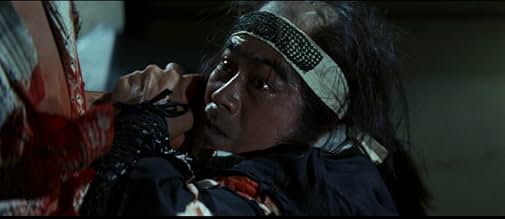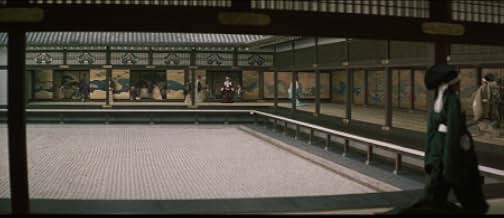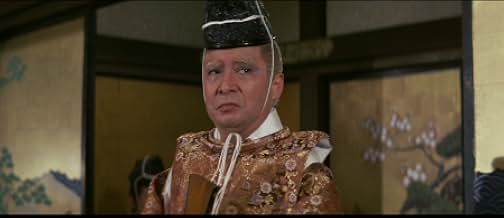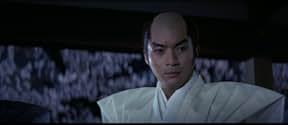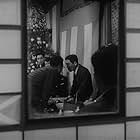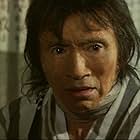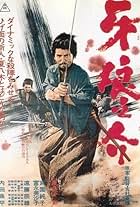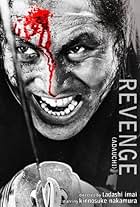This is the story of "The Forty-Seven Ronin." Based on historical events in 1701-2, the movie tells the tale of the Asano clan's downfall and the revenge of its former samurai on the perpetr... Read allThis is the story of "The Forty-Seven Ronin." Based on historical events in 1701-2, the movie tells the tale of the Asano clan's downfall and the revenge of its former samurai on the perpetrator of the catastrophe.This is the story of "The Forty-Seven Ronin." Based on historical events in 1701-2, the movie tells the tale of the Asano clan's downfall and the revenge of its former samurai on the perpetrator of the catastrophe.
- Awards
- 1 nomination
Shin'ichi Chiba
- Kazuemon Fuwa
- (as Sonny Chiba)
Kinnosuke Nakamura
- Kuranosuke Ohishi
- (as Kinnosuke Yorozuya)
Storyline
Did you know
- GoofsThe movie version has all forty-seven Ronin committing seppuku at the end. Only forty-six did so. One was pardoned by the Shogun. He lived to age seventy-eight and died a natural death. He is buried with his forty-six comrades at the famous temple of Sengaku-ji.
Featured review
THE FALL OF AKO CASTLE (1978) is yet another version of the story of the 47 Ronin, a historical event that has resonated in Japanese popular and literary culture for the last 300 years. If you want to try to understand Japanese culture and the Japanese character, a good place to start would be this story and the different versions of it that have been written and filmed over the decades. This film, directed by Kinji Fukasaku for the Toei Studio, is the third version I've seen (with three more waiting) and it compares quite favorably with the others, Kunio Watanabe's THE LOYAL 47 RONIN (1958), done at Daiei and also reviewed on this site, and CHUSHINGURA (1962), done at Toho. All three versions are spectacular productions and highly recommended, but I tend to like the 1958 film best because it explicitly enunciates many of the key details that westerners would need to know to understand the incident and its aftermath. Specifically, it devotes its first 20 minutes to the build-up to the incident that caused so much trouble and led to the downfall of the Asano clan, i.e. Lord Kira's insults directed at Lord Asano and Asano's violent reaction in the Shogun's castle, a violation of court etiquette so severe it results in Lord Asano's death. We understand exactly what happened and why. In Fukasaku's version, the incident is handled rather quickly and gotten out of the way in the film's opening scene, so it helps to have seen the other versions first. Fukasaku's overarching emphasis is on the grieved reactions of the samurai in Asano's clan. We see how the incident and the death of their lord impacted them and how they reacted emotionally. There is some time spent on other factions and other affected parties, but not much. The overwhelming emphasis is on the men and their emotional states during the long build-up to the eventual raid on Lord Kira's residence and the mission of revenge. As such, I found the whole thing very affecting and there are moments during the big finale (which lasts at least a half-hour) when an audience at a screening, especially during the glory days of Japanese film festivals in Manhattan, would have erupted into cheers and applause.
This film has a formal beauty that one doesn't always find in Fukasaku's films. His Yakuza films of the 1970s are filled with gritty street-level cinematography and hand-held camera movement, particularly in the action scenes. There's a whole different aesthetic at work, for the most part, in THE FALL OF AKO CASTLE. The compositions are beautifully lit and designed, boasting a quality that would compare with the visual elegance in both of the cited previous versions of this tale. On the other hand, he brings an occasional chaotic quality to the action sequences and scenes of men in conflict and turmoil that echoes such elements in his Yakuza films. Violence in Fukasaku is rarely choreographed; it's usually quite messy—just like in real life. However, there are moments in the final battle here, particularly when Sonny Chiba goes into action, that are quite artfully staged.
Kinnosuke Nakamura (billed as Kinnosuke Yorozuya for some reason) plays the lead role here, that of Asano Clan Chief Counselor Oishi, who takes command of the samurai following Asano's death. I've seen him in a number of films and TV shows, although I had to consult his IMDb filmography to remind myself which ones. (He starred in the Lone Wolf and Cub TV series.) He tends to blend into whatever ensemble he's cast in and doesn't stand out as much as some of his more famous co-stars here. These include Sonny Chiba as a former clan swordsman who assigns himself the job of bodyguard to Oishi; Tetsuro Tanba (YOU ONLY LIVE TWICE) as Lord Yanagisawa, who decides the ultimate fate of the 47 Ronin; Mariko Okada as Oishi's wife, and an actress famous for having played Akemi, one of Toshiro Mifune's love interests in the SAMURAI trilogy; and Toshiro Mifune himself, in a two-scene cameo as Lord Tsuchiya, who occupies the estate adjacent to Lord Kira and makes his position known once the raid begins. I am quite certain that the old samurai-loving crowd at Japanese film festivals in Manhattan in the 1970s would have burst into applause when Toshiro Mifune makes his first appearance here and again when he makes his declaration of support for the raiders. An audience today would just sit there with blank stares while a handful of us old-timers in the crowd would applaud wildly. I must confess I was unfamiliar with most of the other actors cast in key roles here.
As you can tell, I do wish I'd seen this in a theater with a large, enthusiastic audience. As it stands, I had never even heard of this film until I came across the DVD, under the title SWORDS OF VENGEANCE, in a sale bin at my local FYE (it was $1.78!). Why had this never gotten distribution in the U.S.? And when Adness released it on DVD, how did it slip under my radar? It definitely should be better known.
As for other versions of the 47 Ronin, I have yet to see Kenji Mizoguchi's epic filming of it, made during WWII, or Kon Ichikawa's 1994 rendering. As a completist, I plan to also see Keanu Reeves' 2013 fantasy version, although I have doubts about its fidelity to the source material. There's also a famous TV dramatization from 1971, "Dai Chushingura," also starring Mifune, but I don't know if we'll ever see a subtitled version of it.
This film has a formal beauty that one doesn't always find in Fukasaku's films. His Yakuza films of the 1970s are filled with gritty street-level cinematography and hand-held camera movement, particularly in the action scenes. There's a whole different aesthetic at work, for the most part, in THE FALL OF AKO CASTLE. The compositions are beautifully lit and designed, boasting a quality that would compare with the visual elegance in both of the cited previous versions of this tale. On the other hand, he brings an occasional chaotic quality to the action sequences and scenes of men in conflict and turmoil that echoes such elements in his Yakuza films. Violence in Fukasaku is rarely choreographed; it's usually quite messy—just like in real life. However, there are moments in the final battle here, particularly when Sonny Chiba goes into action, that are quite artfully staged.
Kinnosuke Nakamura (billed as Kinnosuke Yorozuya for some reason) plays the lead role here, that of Asano Clan Chief Counselor Oishi, who takes command of the samurai following Asano's death. I've seen him in a number of films and TV shows, although I had to consult his IMDb filmography to remind myself which ones. (He starred in the Lone Wolf and Cub TV series.) He tends to blend into whatever ensemble he's cast in and doesn't stand out as much as some of his more famous co-stars here. These include Sonny Chiba as a former clan swordsman who assigns himself the job of bodyguard to Oishi; Tetsuro Tanba (YOU ONLY LIVE TWICE) as Lord Yanagisawa, who decides the ultimate fate of the 47 Ronin; Mariko Okada as Oishi's wife, and an actress famous for having played Akemi, one of Toshiro Mifune's love interests in the SAMURAI trilogy; and Toshiro Mifune himself, in a two-scene cameo as Lord Tsuchiya, who occupies the estate adjacent to Lord Kira and makes his position known once the raid begins. I am quite certain that the old samurai-loving crowd at Japanese film festivals in Manhattan in the 1970s would have burst into applause when Toshiro Mifune makes his first appearance here and again when he makes his declaration of support for the raiders. An audience today would just sit there with blank stares while a handful of us old-timers in the crowd would applaud wildly. I must confess I was unfamiliar with most of the other actors cast in key roles here.
As you can tell, I do wish I'd seen this in a theater with a large, enthusiastic audience. As it stands, I had never even heard of this film until I came across the DVD, under the title SWORDS OF VENGEANCE, in a sale bin at my local FYE (it was $1.78!). Why had this never gotten distribution in the U.S.? And when Adness released it on DVD, how did it slip under my radar? It definitely should be better known.
As for other versions of the 47 Ronin, I have yet to see Kenji Mizoguchi's epic filming of it, made during WWII, or Kon Ichikawa's 1994 rendering. As a completist, I plan to also see Keanu Reeves' 2013 fantasy version, although I have doubts about its fidelity to the source material. There's also a famous TV dramatization from 1971, "Dai Chushingura," also starring Mifune, but I don't know if we'll ever see a subtitled version of it.
- BrianDanaCamp
- Apr 13, 2015
- Permalink
- How long is The Fall of Ako Castle?Powered by Alexa
Details
- Release date
- Country of origin
- Language
- Also known as
- The Fall of Ako Castle
- Production company
- See more company credits at IMDbPro
Contribute to this page
Suggest an edit or add missing content


